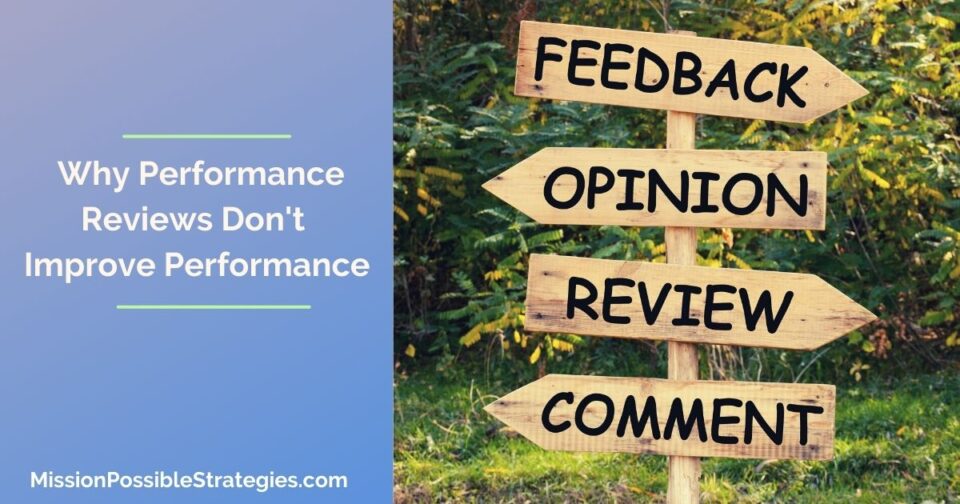For decades, the annual tradition was sitting down with your supervisor and going over your performance review. Most of the time, both supervisors and direct reports dreaded this unpleasant experience.
Recently, companies have begun to focus on creating a “culture of feedback” instead of emphasizing the annual performance review. Does creating a culture of feedback improve performance? Not necessarily. Why?
Of all forms of communication, feedback is perhaps the hardest to give and receive. Therefore, the supervisor is likely to avoid uncomfortable conversations. If the conversation occurs, the recipient of negative feedback is likely to hear “You’re not good enough” which often leads to shame.
What about positive feedback which highlights what an employee did well? Just focusing on the positives won’t necessarily address any weaknesses that are getting in the way of performance.
We’ve forgotten the purpose of feedback in the first place. The purpose of feedback is to help people improve their performance. But here’s the thing: telling people they are missing the mark is not the same as helping them hit the mark.
How can we build a culture of high performance rather than a culture of feedback?
In the book, You CAN Change Other People, Peter Bregman and Howie Jacobson share a four-step process for building a culture of high performance.
Step 1: Shift from critic to ally.
No one wants to talk to a critic. Everyone wants to talk to an ally.
When you’re someone’s ally, you display caring, confidence, and commitment. In your presence, they drop shame and defensiveness and instead focus on becoming better.
So how can you clearly communicate that you’re an ally and not a critic? Here’s a three-step formula:
- Empathize. If your direct report is struggling with a problem, acknowledge how hard or frustrating that must be.
- Express confidence. Let them know you believe in their ability to handle the challenge they’re facing.
- Ask permission. Ask them if they would be willing to work on the situation with you.
If an employee tells you, “I’m so frustrated because I’m struggling to meet deadlines since I got promoted,” you could say, “It’s perfectly understandable to feel frustrated when you’re having trouble meeting deadlines. I’ve seen you overcome obstacles in the past so I know you can do this. Can we work on this together?”
Step 2: Identify an energizing outcome.
Once the employee has said yes to working on the problem with you, focus on the energizing future they want to create; i.e., a future that is bigger than their problem. Ask, “What is the outcome you’re going for?” Allow them to articulate what they’re trying to achieve, both for themselves and for the organization.
I’ve found that asking, “What do you really want?” is one of the most powerful questions a coach can ask. Help your employee articulate an outcome that is positive, clear, and meaningful. For example, in the scenario above, the outcome might be, “I want to build a cohesive team so we can all feel successful together.”
Step 3: Discover a hidden opportunity.
When you’re both clear about the outcome, then you can revisit the problem. But instead of trying to “solve” it, ask, “How can this problem help us achieve the outcome we’re working toward?” In the example above, you might explore, “How can meeting your deadlines help you build a cohesive team?”
Step 4: Create a level-10 plan.
In the final step, you guide the employee to brainstorm ways of capitalizing on the opportunity and committing to a plan of action to achieve it. Then ask the employee, “On a scale of 1-10, how confident are you that you will execute this plan?” If the answer is a resounding 10, that is a Level 10 Plan. The most important thing is for the employee to follow through on taking new action and assessing the results.
Summary: Feedback can be a tool to help people identify their blind spots and opportunities for growth when it’s embedded in a true process of growth and development.
And Remember…You’re not alone. You can do this!
Sources:
How to Have Difficult Conversations When You Don’t Like Conflict by Joel Garfinkle
Giving Feedback When You’re Conflict Averse by Amy Jen Su
Feedback Isn’t Enough to Help Your Employees Grow by Peter Bregman and Howie Jacobson


